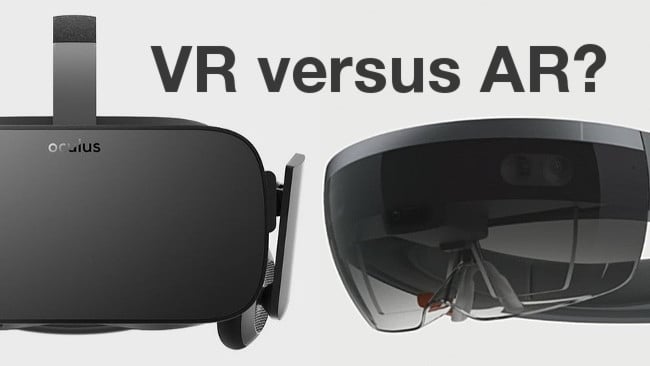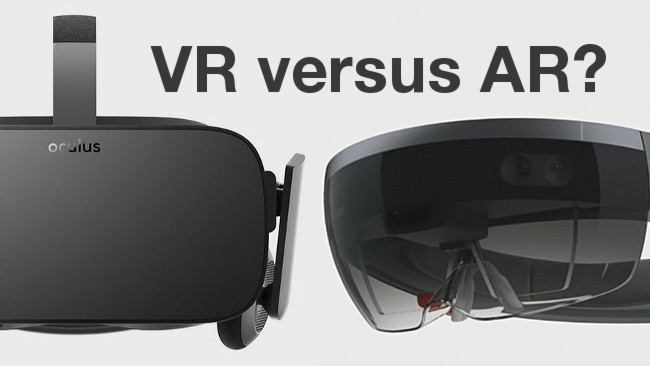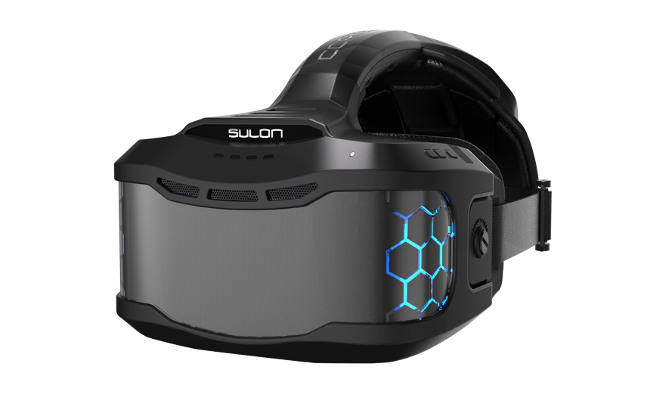
 Virtual reality versus augmented reality?
Virtual reality versus augmented reality?
Virtual and augmented reality is a hot industry that's ready to take off. Or is it two industries? Or are we headed for a future where the distinction between VR and AR is practically irrelevant?
From time-to-time, a topic we cover on RedShark News will bring about a fierce internal debate among our editors and contributors. This usually happens when we're faced with 'big questions' for the industry. We ran a spate of opinion articles in the run-up and adoption of 4K acquisition that ran the gamut of possible viewpoints. Similarly, the subject of virtual / augmented reality has sparked a debate among our staff, as they are the technologies at our doorstep knocking for entrance.
A few weeks back, we ran an article 'Virtual reality is about to boom...' that outlined where we're at and what's on the horizon, meant to convey the incredible gathering momentum for virtual and augmented reality. Since then, our European Editor, Andy Stout, penned something of a response, relegating VR to 'sideshow' or warm-up act status as compared to the main event, augmented reality. I must say that Andy is one of the smartest and most experienced commentators on media and technology working and I do agree with some of his finer points. But I can't agree that AR will be the 'winning' tech over VR because I think predicting such a winner ignores where the two sister technologies are likely headed.
Truth in numbers?
Andy referenced a report from business investing site Digi-Capital that we first mentioned in our 'ready to boom' article, which has the shock forecast of a $150B combined VR and AR industry by 2020. In 'about to boom', this forecast was at the high-end of a range of industry forecasts for VR industry that we mentioned, but Digi-Capital's forecast was the only one that took into account AR. In its projections, Digi-Capital asserted that in 2020, the AR industry would be worth $120B and the VR industry around $30B. So, that means AR will be the clear winner, right?
Well, let's take a step back and consider what we're really doing when we make and rely upon such predictions. In this case, the Digi-Capital report assumes that, in 2020, there will be two distinct and clearly definable industries, one for VR and another for AR, which is the basis for Andy's argument. But, as Oculus Rift inventor Palmer Luckey said, the best headsets in the future will feature both fully immersive VR and AR that blends with a user's real world field of view.
If the future of VR and AR is the hybrid headset, then it's also the future of VR and AR content and user experience: namely, seamless and interactive shifting between immersive and augmented realities. In a future in which, say, an engineer could have a 3D schematic AR overlay of what he-or-she is working on, make an eye or hand gesture to enable VR mode, manipulate the schematic in an immersive view that cuts out visual distractions and switch back to AR mode to continue working in the real world, It probably won't make much sense to divide VR and AR into distinct and separate industries.
The future or the present?
You may be wondering just how long this convergence between VR and AR will take. I would posit that if Oculus inventor Palmer Luckey is talking about a hybrid VR and AR headset, it's because the company is in the very early stages of developing such a product. Of course, that places an Oculus VR/AR headset release in the indeterminate future (if it happens at all), but there are already multiple projects at the prototype and demo phases that aim to bring VR and AR together in one headset.
 Sulon Cortex
Sulon Cortex
Founded in 2012, Sulon Technologies has been committed to bringing a headset to market that gives users VR and AR capabilities. The device, dubbed the Sulon Cortex, has had many prototype iterations, starting as a headset that used a smartphone as its display. But the project has since been refined to two demo models, one PC tethered with spatial tracker (an inside-outside system for body position tracking) and sensors for head tracking gesture input, and one untethered without the spatial tracker. Both models use a different approach to augmented reality than Magic Leap's light field technology, which functions by shining light directly into users' eyes. Through the output feed of two strategically-placed cameras on the Sulon Cortex, the stereo 3D image of the real world is displayed through the headset, augmented by interactive 3D visuals and an immersive VR experience just a gesture or two away.
While some may cry that the Sulon Cortex isn't a 'genuine' AR headset, one of the big knocks on Magic Leap (from the handful of people who have demoed it) and especially Microsoft Hololens, is the comparatively small field of view for these early generation AR headsets. While the horizontal field of view for the Oculus Rift consumer version will be 110 degrees, the Magic Leap and Hololens are something in the range of 40-degrees horizontal. (Magic Leap at least has a something around 40x40 degree FOV, whereas Hololens is around 40x20). Sulon Technologies claims the Cortex has a 140-degree field of view (presumably horizontal) and offers a camera-enabled AR experience that will cover the headset's full FOV, along with VR functionality.
The Sulon Cortex dev kit will be available later this year for $499.
Like the Sulon Cortex, the Gameface HMC (Head Mounted Console) from Gameface Labs is waiting in the wings to with a hybrid VR and AR headset of its own that sports some impressive specs on paper. The current prototype aims to be a fully self-contained Android VR / AR device with a nVidia SoC (the quad core, 2.3 GHz TK1, which will upgrade to the TX1 when available), which the company claims is "more powerful than two Xbox 360s strapped to your head." It also features 4GB of RAM, SSD flash storage, 2560x1440 total resolution and a 140 FOV. And, like the Sulon Cortex, it uses on-board cameras for a stereoscopic 3D video feed as the 'real world' view for its augmented reality experience. Price of the dev kit has not been announced, but the company has slated for it to arrive in Q2 2016.
Smartphone AR?
If you would like to experiment with VR and AR in one device and use your smartphone to do it, there's the recent Kickstarter success Cmoar, which is taking pre-orders through its site. For between $99 and $250, you can get a Google Cardboard-style headset with a modular lens system. Users can literally swap out VR, 3D video and 2D video eye pieces. Perhaps most interestingly, the company claims augmented reality functionality, although the supplied smartphone must have a 3D camera to enable AR.
The Cmoar headset does have low latency sensors that should make head tracking and gesture control more precise, but as most smartphones don't have 3D cameras, so AR may not be a big selling point for the Cmoar headset, unless smartphone manufacturers start designing their products specifically with VR and AR headset-implementation in mind...
Agree to disagree
I do agree with Andy that AR will likely be used more often than VR by users. But, in the future, that decision will happen during use, not at purchase, and hardware and software makers will make the most of this newfound ability to shift from augmented to immersive realities and back again.
Tags: VR & AR


Comments